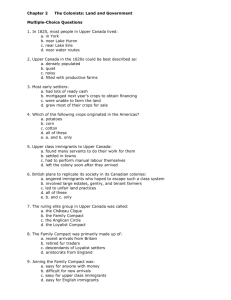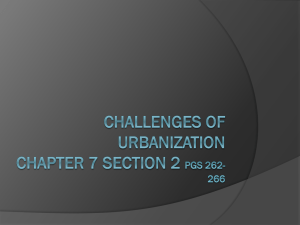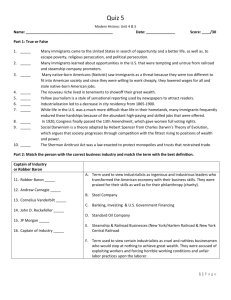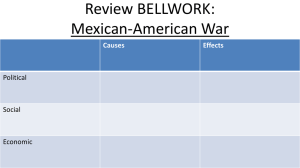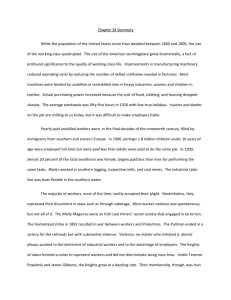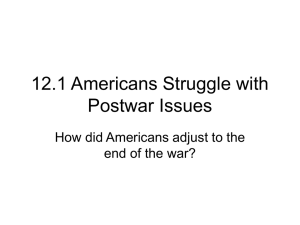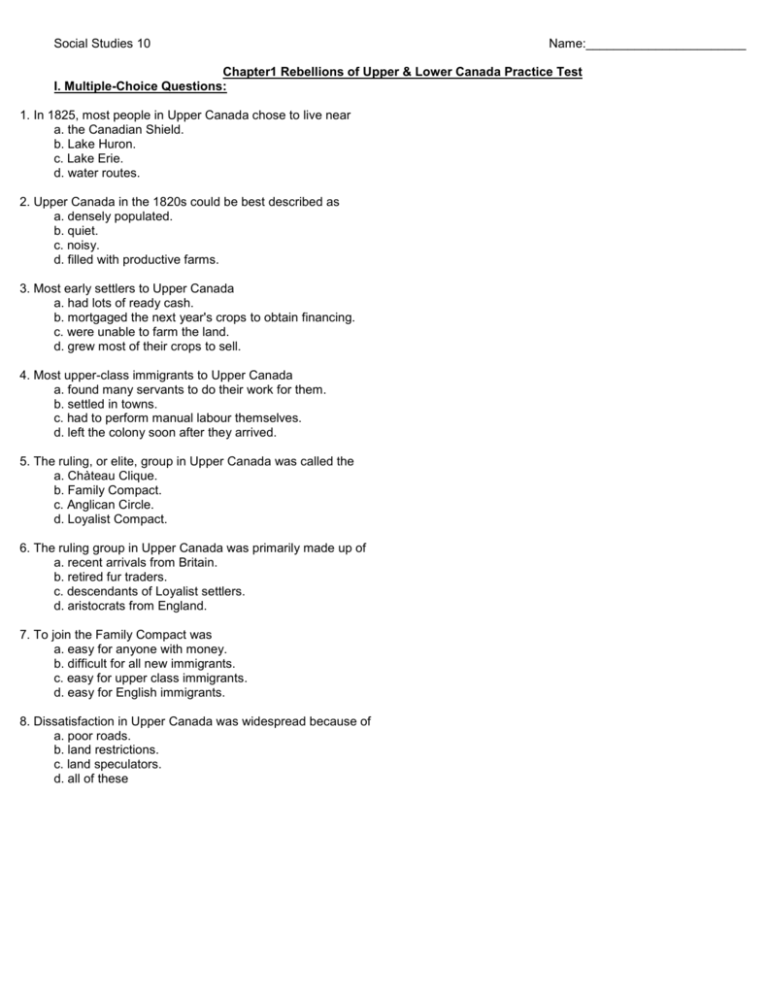
Social Studies 10
Name:_______________________
Chapter1 Rebellions of Upper & Lower Canada Practice Test
I. Multiple-Choice Questions:
1. In 1825, most people in Upper Canada chose to live near
a. the Canadian Shield.
b. Lake Huron.
c. Lake Erie.
d. water routes.
2. Upper Canada in the 1820s could be best described as
a. densely populated.
b. quiet.
c. noisy.
d. filled with productive farms.
3. Most early settlers to Upper Canada
a. had lots of ready cash.
b. mortgaged the next year's crops to obtain financing.
c. were unable to farm the land.
d. grew most of their crops to sell.
4. Most upper-class immigrants to Upper Canada
a. found many servants to do their work for them.
b. settled in towns.
c. had to perform manual labour themselves.
d. left the colony soon after they arrived.
5. The ruling, or elite, group in Upper Canada was called the
a. Chàteau Clique.
b. Family Compact.
c. Anglican Circle.
d. Loyalist Compact.
6. The ruling group in Upper Canada was primarily made up of
a. recent arrivals from Britain.
b. retired fur traders.
c. descendants of Loyalist settlers.
d. aristocrats from England.
7. To join the Family Compact was
a. easy for anyone with money.
b. difficult for all new immigrants.
c. easy for upper class immigrants.
d. easy for English immigrants.
8. Dissatisfaction in Upper Canada was widespread because of
a. poor roads.
b. land restrictions.
c. land speculators.
d. all of these
PAGE 4
9. The clergy reserves were established for the benefit of
a. all church groups.
b. the Catholic Church.
c. the Anglican Church.
d. any Protestant church.
10. The Crown and clergy reserves together consisted of how much of Upper Canada's land?
a. one-quarter
b. one-third
c. one-seventh
d. two-sevenths
11. The Crown and clergy reserves caused problems because they were
a. scattered, and this blocked road development.
b. often sold to poorly trained farmers.
c. concentrated in one area, on the worst land.
d. available only to members of the Family Compact.
12. The British government considered which of the following to be the best group to control most of the land in Upper Canada?
a. republican farmers
b. aristocrats
c. ordinary farmers
d. skilled farmers
13. By 1815, half the land in Upper Canada was owned by
a. individual settlers.
b. the British government.
c. land speculators.
d. the Family Compact.
14. Most immigrants to British North America in the early 1800s came from
a. France and Britain.
b. the United States and Britain.
c. France and the United States.
d. Britain and Germany.
15. After the War of 1812, most immigrants to British North America settled
a. in the Eastern Townships.
b. in Upper Canada.
c. along the St. Lawrence River.
d. on the shores of Lake Huron.
16. Immigrant ships were often called 'coffin ships" because of the
a. shape of the vessels.
b. high cost of passage.
c. many immigrants who would never return home.
d. many immigrants who died on the voyages.
17. Most immigrants to British North America in the early 19th century travelled in
a. first-class cabins.
b. second-class cabins.
c. steerage.
d. tents on the ships' decks.
18. For most immigrants coming to British North America, living conditions on the ships were
a. clean.
b. well-ventilated.
c. filthy.
d. comfortable.
PAGE 5
19. British North America attracted most immigrants with the promise of
a. jobs in manufacturing.
b. high wages for servants.
c. large gold deposits.
d. owning their own land.
20. By today's standards, 19th-century Canadians can be considered to have been
a. tolerant of diversity.
b. almost exclusively English.
c. racist.
d. open to new ideas.
21. Black Americans travelled to Canada via the Underground Railroad, so named because
a. it was a network of secret trails.
b. people travelled in boxcars.
c. it was an early form of subway.
d. people hid in tunnels to avoid detection.
22. In pioneer society, unmarried women were most often
a. admired.
b. pitied.
c. shunned.
d. sent to convents.
23. Most upper-class women in Upper Canada were
a. lazy.
b. idle and attended to by many servants.
c. required to help run the farm.
d. only active in social clubs.
24. Government in Upper and Lower Canada was run by small groups of rich, powerful men. This is known as a/an
a. dictatorship.
b. oligarchy.
c. democracy.
d. autocracy.
25. Any bill passed by the Legislative Assembly in Upper Canada
a. automatically became law after thirty days.
b. needed final approval from the Irish parliament.
c. was sent to public meetings for feedback and approval.
d. could be vetoed by the governor and the appointed councils.
26. Which of the following was not a concern of ordinary people in Upper Canada?
a. the clergy reserves.
b. business expansion.
c. land speculation.
d. the Crown reserves.
27. When Robert Gourlay criticized the government of Upper Canada, he was
a. thanked by the colonial government.
b. indifferent to complaints from farmers.
c. arrested and deported.
d. paid by the government and ignored.
28. The leading reformer in Upper Canada in the 1820s and 1830s was
a. Robert Gourlay.
b. John Strachan.
c. Louis-Joseph Papineau.
d. William Lyon Mackenzie.
PAGE 6
29. In Upper Canada in the 1830s, voting was
a. restricted to males.
b. fair and honest.
c. free of bribery.
d. by secret ballot.
30. A problem that existed in Lower Canada, but not in Upper Canada, was
a. rule by an oligarchy.
b. a government that ignored ordinary people.
c. a split between English and French society.
d. no responsible government.
31. The Chàteau Clique was dominated by
a. the Catholic Church.
b. English merchants.
c. wealthy seigneurs.
d. fur traders.
32. Reformers in Lower Canada were angry that the British government wanted to raise taxes on
a. land, but leave businesses untaxed.
b. the Catholic Church, but not the Anglican Church.
c. only French-speaking businesses.
d. both land and businesses.
33. The leaders of the reform movement in Lower Canada were
a. all French.
b. both French and British.
c. all British.
d. all Irish.
34. French Lower Canadians were most concerned at the possibility their
a. crops were being undervalued.
b. culture was being undermined.
c. seigneurial system was threatened.
d. Catholic faith was under attack.
35. When the British government rejected a petition from Lower Canadian reformers,
a. the reform movement dissolved.
b. the reformers sought union with the United States.
c. the reformers rebelled against the government.
d. the reformers wrote a new petition.
36. The Rebellions of 1837 in Upper and Lower Canada were
a. well planned and carried out.
b. poorly coordinated.
c. spontaneous.
d. without leaders.
37. The Rebellion of 1837-1838 in Lower Canada
a. almost succeeded.
b. disintegrated when its leaders quarrelled.
c. was a peaceful protest.
d. was suppressed by British troops.
38. The Rebellion of 1837 in Upper Canada was
a. supported by a majority of reformers.
b. a well-organized attack on Toronto.
c. poorly led and conducted.
d. the beginning of more violent revolts.
PAGE 7
39. In the aftermath of the Rebellions in Upper and Lower Canada, the British government
a. immediately granted sweeping reforms.
b. appointed a new Governor-in-Chief to investigate the rebellions.
c. captured and hanged Papineau and Mackenzie.
d. increased the number of troops and took no other action.
40. Upon arriving in 1838, Lord Durham discovered that he had
a. complete public support in the Canadas.
b. no support at all in the Canadas.
c. little support in the Canadas.
d. the support of the Americans.
41. As a result of Lord Durham's findings, the British government decided to
a. keep the Canadas separate, but introduce responsible government.
b. unite the Canadas and introduce responsible government.
c. unite the Canadas, but without responsible government.
d. break the Canadas into smaller colonies that could be ruled from Britain.
II. Short Answer Questions:
1. Describe three effects that Crown and clergy reserves had on settlement and development in Upper Canada. In your answer,
identify what proportion of the colony's land was held in these reserves.
2. Identify three factors that led people to immigrate to Canada.
3. Pioneer life in Upper Canada was harsh and difficult. Evaluate this statement, providing at least four reasons to support your
position.
4. Discuss the prevalence of racism in Upper Canada. Keep in mind English and European attitudes of the time.
5. Moving to Canada was often disappointing to Black Americans. Evaluate this statement and provide three examples to support
your position.
6. Describe five reasons that led to demands for government reform in 1830s Upper Canada.
7. Describe five reasons that led to demands for government reform in 1830s Lower Canada.
8. Compare and contrast the Rebellions of 1837 in Upper and Lower Canada. Identify four ways in which they were similar and
three ways in which they were different.
9. Identify the bias revealed in Lord Durham's Report. How did his report hope to solve the "language" problem? Also describe
Durham's attitude towards the reformers.
10. "The Act of Union (1840) fully implemented the provisions of Lord Durham's Report." Evaluate this statement.
11. Identify five resources that were available to the pioneers in Upper Canada and how they were used. You may want to refer to
this chapter's Window on the Past.
12. Explain Prime Minister Mackenzie King's remark that Canada "has too much geography."
PAGE 8
Skills Questions
[Teacher: Provide copy of Table 1-1, Horizons, p. 15]
[Note: Students will need a calculator.]
Use the copy of Table 1-1 provided to answer the questions below. You will need a calculator.
1. Which type of animal provided the most skins?
2. Which type of animal generated the most income?
3. There were 20 shillings (s) in a pound (á) and 12 pence (d) in a shilling. Calculate the price of each of the following in á s d.
Muskrat Beaver Bear Otter 4. If otter fur was so valuable, why do you think it was that more otters were not trapped?
[Teacher: Provide copy of Figure 1-8, Horizons, p. 16]
5. Which was the largest town?
6. By 1825, the shores of which lake had not been settled?
7. Based on this map and your reading of Horizons, describe three possible reasons why no settlement had occurred more than
100 km from water routes?
[Teacher: Provide copy of Figure 1-15, Horizons, p. 23. OMIT CAPTION]
Use the map provided to answer the questions below. You will need a calculator.
8. How many people travelled through to the United States via the Canadas?
9. Based on this map, what was the net migration from the Canadas to the United States?
10. A total of 237 000 people came to the Canadas during this period. What percentage of this total went to the Ottawa Valley?
Quebec City? Toronto? the United States?
11. Based on this map and your reading of Horizons, explain why more immigrants chose to settle in Upper Canada than in Lower
Canada?
[Teacher: Provide copy of Figure 1-29, Horizons, p. 37]
Use the copy of Figure 1-29 provided to answer the questions below.
12. Compare and contrast the French social structure with that of the English. Provide at least two ways in which they are similar
and three ways in which they are different.
13. Based on Figure 1-29 and your reading of Horizons, explain why this social structure would cause resentment in Lower Canada.
Provide at least three reasons and describe the kind of citizenship status the French had under this structure.
Multiple Choice- Answers:
1. d
Chapter:1
QUESTION: 10
Chapter:1
QUESTION: 11
Chapter:1
QUESTION: 12
Chapter:1
QUESTION: 13
Chapter:1
QUESTION: 14
Chapter:1
QUESTION: 15
Chapter:1
QUESTION: 16
Chapter:1
QUESTION: 17
Chapter:1
QUESTION: 18
Chapter:1
QUESTION: 19
Chapter:1
QUESTION: 20
Chapter:1
QUESTION: 21
Chapter:1
QUESTION: 22
Chapter:1
QUESTION: 23
Chapter:1
QUESTION: 24
Chapter:1
QUESTION: 25
Chapter:1
QUESTION: 26
Chapter:1
QUESTION: 27
2. b
3. b
4. c
5. b
6. c
7. b
8. d
9. c
10. d
11. a
12. b
13. c
14. b
15. b
16. d
17. c
18. c
PAGE 3
19. d
Chapter:1
QUESTION: 28
Chapter:1
QUESTION: 29
Chapter:1
QUESTION: 30
Chapter:1
QUESTION: 31
Chapter:1
QUESTION: 32
Chapter:1
QUESTION: 33
Chapter:1
QUESTION: 34
Chapter:1
QUESTION: 35
Chapter:1
QUESTION: 36
Chapter:1
QUESTION: 37
Chapter:1
QUESTION: 38
Chapter:1
QUESTION: 39
Chapter:1
QUESTION: 40
Chapter:1
QUESTION: 41
Chapter:1
QUESTION: 42
Chapter:1
QUESTION: 43
Chapter:1
QUESTION: 44
Chapter:1
QUESTION: 45
Chapter:1
QUESTION: 46
Chapter:1
QUESTION: 47
Chapter:1
QUESTION: 48
20. c
21. a
22. b
23. c
24. b
25. d
26. b
27. c
28. d
29. a
30. c
31. b
32. a
33. b
34. b
35. c
36. b
37. d
38. c
39. b
PAGE 4
40. c
Chapter:1
QUESTION: 49
Chapter:1
QUESTION: 50
41. c
Short Answer Answers:
1. Crown and clergy reserves contained two-sevenths of all land in Upper Canada. They made settlement difficult because a great
deal of prime farmland was thus unavailable to settlers. And because so much of the reserves land was undeveloped, roads
were not built and transportation was difficult. The reserves were essentially put aside for two groupsÄÄthe Anglican Church
and the Family Compact. These groups, especially the Family Compact, already had a great deal of power and control, and
the way they hindered development on the reserves led to great resentment and discontent among settlers.
Chapter:1
QUESTION: 1
2. Almost all immigrants to Canada were attracted by the promise of owning land. In Ireland and Scotland, thousands of
impoverished farmers had been displaced by enclosure: for them, Canada was a chance for a new life. In Britain's crowded
cities, factories offered little hope, and again Canada seemed to offer more opportunity. Younger children of upper-class
British families were unlikely to inherit land in Britain, so coming to Canada was a way for them to acquire land.
Chapter:1
QUESTION: 2
3. Pioneers to Upper Canada confronted many hardships. They had to clear land before they could raise crops. Because of soil
conditions, it could take twenty years or more before enough land could be cleared so that farms could prosper. Often families
had to borrow money, which could take years to repay. There were also very few roads, and these were in poor condition and
poorly designed. As a result, it was hard to transport goods or to travel. In addition, there were very few services.
Chapter:1
QUESTION: 3
4. Racism, as we would view it today, was common in Upper Canada. Many settlers believed in the superiority of European
civilization. The English, in particular, believed they had a "destiny" to lead the world. Irish and Black immigrants, and Native
peoples, were often the victims of racial discrimination.
Chapter:1
QUESTION: 4
5. Many Black Americans immigrated to Canada expecting to find freedom and equality in a colony where slavery had been
abolished. Often, however, they experienced as much discrimination in Canada as they had in the United States. Black
immigrants did not find widespread acceptance and often built their own small communities in remote areas. They had no
voice in government for more than 100 years. Some Black immigrants to Canada were so disappointed by conditions in
Canada that they chose to return to Africa.
Chapter:1
QUESTION: 5
6. PowerÄÄand landÄÄwas concentrated in the hands of a few powerful groups. The Family Compact, for example, did not
respond to the needs of new immigrants. It was also impossible for most immigrantsÄÄeven the upper-class EnglishÄÄto join
the Family Compact. The Crown and clergy reserves occupied huge tracts of land, but were undeveloped. The clergy
reserves were controlled entirely by the Anglican Church and were used solely for its benefit. The colony of Upper Canada
was experiencing large inflows of immigration, yet it lacked services, and the government was unwilling to provide them.
When settlers voiced their concernsÄÄand a need for reformsÄÄthe government did not respond.
Chapter:1
QUESTION: 6
PAGE 5
7. In Lower Canada the English dominated the French, who formed the vast majority of the population. This led to widespread
resentment. After all, Lower Canada had been a colony of France for hundreds of years. The French wanted their language
and culture protected, but the actions of the British government often threatened this. Worse, the colonial government taxed
French landholders, but not British merchants. Finally, when reformers in Lower Canada (including English members and
leaders) presented petitions to the government, they were ignored or outright rejected.
Chapter:1
QUESTION: 7
8. The Rebellions of 1837 in both Upper and Lower Canada were the result of years of built-up frustration. In both colonies, the
rebellions were planned but poorly executed. In both colonies, the government effectively suppressed the uprisings. Leaders
of the reform movement in both colonies were exiled, punished, and, in some cases, publicly executed. The rebels in Lower
Canada, however, had much more public support. They were seen as defending a "nation" or a way of life. In Upper Canada,
the demands for reform were more focused on economic and social factors.
Chapter:1
QUESTION: 8
9. Durham's document reveals that he held preconceived attitudes and ideas. As a wealthy man with progressive ideas, he
seemed to favour rebels. At the least, he was sympathetic to their demands for reform. When it came to the French in Lower
Canada, however, the document makes clear his prejudice against them. By advocating the union of Upper and Lower
Canada, Durham hoped to assimilate the French into English culture.
Chapter:1
QUESTION: 9
10. The Act of Union did implement two key points of Durham's Report. It united Upper and Lower Canada (in 1841 they became
"United Canada"), and it provided elected assemblies. It did not, however, introduce responsible government.
Chapter:1
QUESTION: 10
11. Pioneers in Upper Canada had access to wool (for clothing), animal hides (for leather), maple syrup (for sugar), fertile soils
(once the land was cleared, for farming), and lumber (for building, heating, and cooking).
Chapter:1
QUESTION: 11
12. Canada is a vast countryÄÄthe second largest, in terms of area, in the world. Yet it is sparsely populated. Most of Canada's
population lives close to the US border on coastlines. This makes it difficult to develop such a large area, particularly when so
much of the land lies in the high latitudes.
Chapter:1
QUESTION: 12
Skills Questions
1. Deer
Chapter:1
QUESTION: 1
Chapter:1
QUESTION: 2
2. Beaver
3. Muskrat: 6.7d; Beaver: 11s 3d; Bear: á1 1s 7d; Otter: á2 9s 9d (divide total á by number of skins, then divide fractions by 20 for
shillings, and then by 12 for pence).
Chapter:1
QUESTION: 3
4. Beavers were more plentiful than otters, and otters may have been more difficult to trap. As well, otter pelts may have had fewer
commercial uses.
Chapter:1
QUESTION: 4
5. Kingston
Chapter:1
6. Lake Huron (including Georgian Bay)
Chapter:1
QUESTION: 5
QUESTION: 6
PAGE 6
7. It was easier to travel and transport goods over water than overland because few roads had been built in Upper Canada by
1825. Early settlers also tended to take up land closer to water, both for transportation and water supply. Much of the land
that had been settled in 1825 was also more fertile and more easily farmed than land in unsettled areas further inland.
Chapter:1
QUESTION: 7
8. 29 000
Chapter:1
QUESTION: 8
9. 1000 (29 000 to US, less 28 000 from the US)
Chapter:1
QUESTION: 9
10. Ottawa Valley: 8.0% (237 000 / 19 000 ð 100); Quebec City: 7.6% (237 000 / 18 000 ð 100); Toronto: 13.5% (237 000 / 32 000
ð 100); United States: 12.2% (237 000 / 29 000 ð 100)
Chapter:1
QUESTION: 10
11. In Upper Canada, more land was available for settlement. Most immigrants were English-speakers from the US and Great
Britain, so the fact that Upper Canada was English-speaking was attractive to them. This also meant there was a greater
likelihood that immigrants might have relatives already settled here.
Chapter:1
QUESTION: 11
12. In both Upper and Lower Canada, the structure is stratified into the upper (Petty Nobility), middle (Bourgeoisie) and lower (The
People) classes. The composition of each of these levels is similar in both Upper and Lower Canada. In both colonies, the
Native peoples occupy the lowest social position. Lower Canada has a three-tiered system, with all French classes lower than
any English level. The French are excluded from the ruling elite, and French professionals have lower status than English
merchants.
Chapter:1
QUESTION: 12
13. The social structure of Lower Canada turned the French into second-class citizens. It led to resentments because the French
had arrived here first and had a long history of settlement, customs, and language. They also vastly outnumbered the English,
yet had no real power in government. It was also clear to many people in Lower Canada that the British had limited sympathy
for the Catholic Church and the French language. Because of the arbitrary nature of British rule, resentments continued to
build.
Chapter:1
QUESTION: 13
(c) 2000, Prentice Hall Ginn Canada. All rights reserved.


